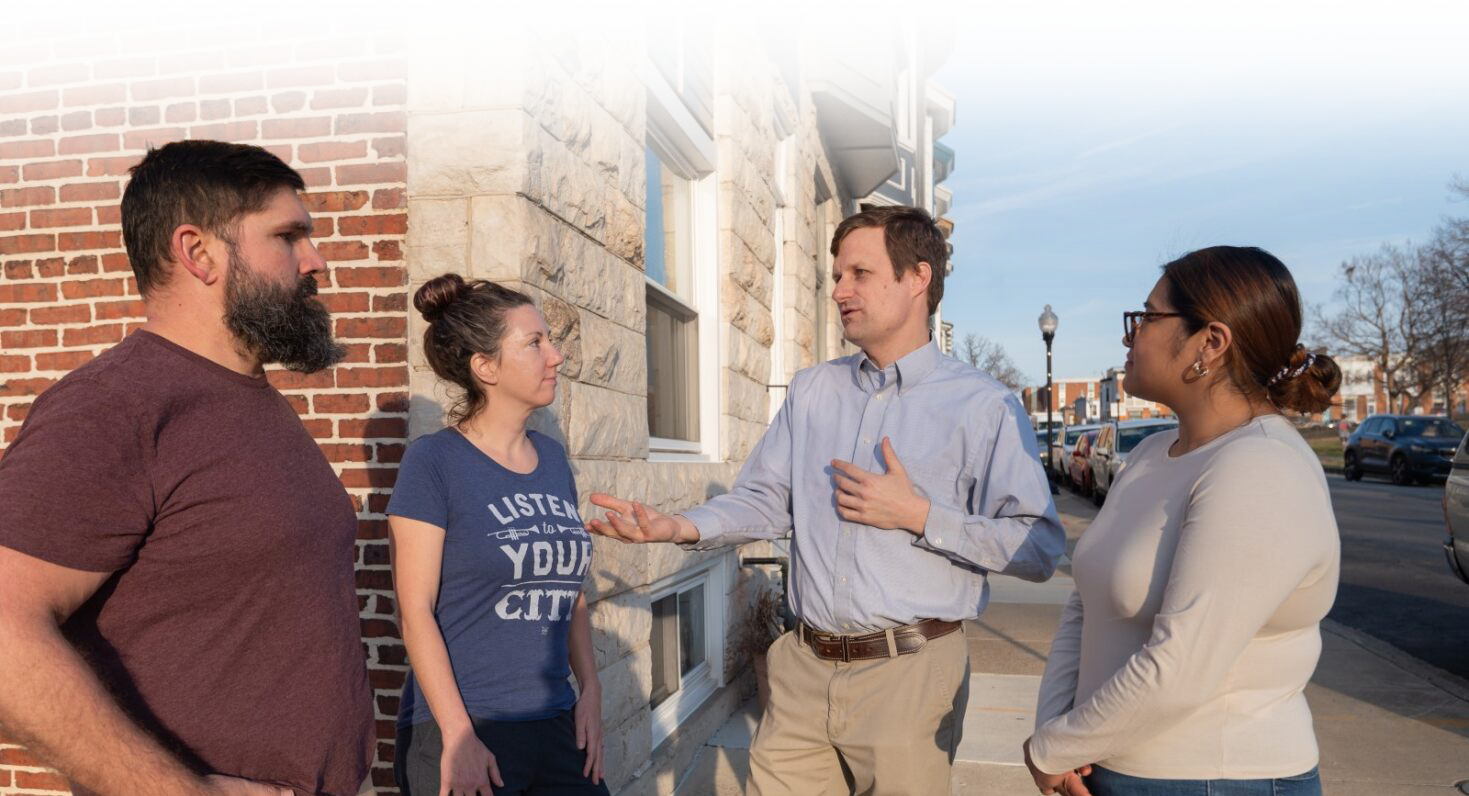
Vision & Values:
People in healthy, livable communities need to have a reasonable expectation of safety. Even as we work each day to make our communities safer, our deeper goal for our neighborhoods is peace. Safety and peace are complimentary, but not interchangeable. Safety is the absence, or at least the limitation, of criminal activity. Peace is a proactive, genuine, comprehensive commitment to community well-being. Peace is something we build and create together, and which provides all area residents with safety, respect, opportunity, and connection within our communities.
Leadership & Experience:
I have fifteen years of engagement and leadership on matters of public safety in our communities.
Some of that work has been very granular: working with neighbors and police to uproot drug dealing on specific corners, helping with short term and long term fire response, improving lighting in certain areas and blocks, participating in community safety walks, supporting individual projects and specific legislation related to pedestrian and cyclist safety. It’s also meant involvement in investigations and court cases stemming from criminal activity in our community, including theft, professional misconduct, domestic violence, burglary, assault, and murder.
Some of that work has been relational: building effective working relationships with commanders in the Southeastern and Central districts, helping foster connections between officers and community members (especially across barriers of language and culture), and building direct relationships with key officers and staff from the State’s Attorney’s office.
And some of that work has involved working with broader coalitions: multiple years of active engagement with the Southeastern Community Relations Council, serving on the Latino Public Safety task force, serving on the Baltimore Highlands task force, and writing and implementing community public safety grants.
Priorities:
The councilperson’s responsibilities regarding public safety fall into two main categories.
Relationships & Communication: the councilperson must be proactive in building and renewing working relationships with police, fire, and state’s attorney leaders active in our area. There are often transitions in leadership in those roles, and the councilperson must be engaged to help bring new commanders up to speed and connect them with key stakeholders around the district. When particular safety concerns arise around the district, the councilperson must judiciously elevate them to the attention of commanders for action. At times, like with the Baltimore Highlands and the Latino Public Safety task forces, there is an organizing/collaborating role for the councilperson’s office.
Budgeting & Accountability: the councilperson plays a key oversight role in the efficient functioning of public safety departments, in evaluating and approving new leaders, and in reviewing the effectiveness of different strategies.
Improving Safety
Staffing & Recruitment: Our fire department and police department are both struggling to recruit new staff members. While this is true for public safety agencies around the state, the council needs to work closely with agency leadership to develop and support effective strategies to reverse those trends. The cumulative effect of staffing shortages (short-handed shifts leading to ineffective coverage, overwhelming overtime expenses, significant mandatory overtime leading to ineffectiveness and burnout) are alarming. For both agencies, recruiting young Latina/o members who have grown up and continue to live here in Baltimore City is a particularly significant opportunity. In addition to providing necessary staff, such recruitment will address some critical language and cultural competency deficiencies among first responders.
988—the 911 Behavioral Health Diversion Program: Community members and community-based professionals have long noted the lack of an effective first response for people in crisis due to addiction and/or mental health. Police and fire personnel, who have traditionally been tasked with this response, struggle to provide support in situations for which they lack training and expertise. Meanwhile, the volume and complexity of these calls have prevented their being available to respond to fires and criminal activity. The Behavioral Health Diversion Program launched in 2021 and has seen good results to this point. But building up a robust and effective first response for addiction and mental health concerns will require sustained funding, political leadership, and increasing staffing. We will also need elected officials and community members to help with outreach and awareness, particularly in neighborhoods which such challenges are prevalent.
Property crimes (package theft and car break-ins, for the most part) are primarily driven by addiction in our communities. We can and should do more to make such crimes more difficult (street lighting, delivery boxes, effective communication among residents, more officers on patrol). Car thefts have a different dynamic. Hardening targets is one necessary approach, as well as utilizing cameras and license plate readers to better investigate such matters. A proactive approach to prosecutions will help people understand the serious consequences of car thefts—especially for repeat offenders.
Violent crime (murders, assaults, robberies, carjackings, etc.) are currently trending in positive directions. It is vital that we encourage this momentum. Close collaboration with Ivan Bates’ office is a key component, especially in helping support victims and in empowering their involvement, and that of other community members, in speaking to community impact as it relates to decisions around prosecution and sentencing. Ivan has done a good job rebuilding that office, in terms of number of staff, competence, and morale.
The mayor’s Group Violence Reduction Strategy is yielding good results in our city, and repeated studies have demonstrated significant effectiveness around the country. That strategy needs to be fully supported in its city-wide implementation. Focusing our resources and energy in terms of proactive interventions with those most likely to commit and to be victims of violent crime allows us to save lives, improve community safety, and appropriately limit over policing in communities of color. Such an approach is consistent with our consent decree obligations, and are central to our path toward an effective and community-responsive police force.
Building Peace
Rebuilding Livable Communities: Much of the violence that exists in our city is committed by a relatively small group of people, many of whom share the experience of growing up in distressed communities marked by poverty, vacancy, unemployment, and repeated cycles of violence. The traumatic nature of daily life in these communities hurts residents and increases the likelihood that they will perpetrate or become victims of violence.
Addiction Treatment: The underlying dynamics driving property crime won’t change unless we significantly expand the access and effectiveness of drug treatment and mental health services. More importantly, each year in our city we lose far more people to overdose than we do to violence. We need to do all we can to protect our neighbors and support them in rebuilding their lives.
Mental Health Support: Expanding the network of community-based practitioners (particularly in schools, libraries, and other key institutions) will significantly increase access to care and allow communities to build resiliency in the midst of trauma. This includes support for victims of violent crime.
Access to Economic Opportunity: It is repeated often, but it holds true that the best prevention for violence or criminal activity is a job. Ensuring that all of our neighbors have the opportunity to work and to support their families, especially newly-arrived neighbors and young people entering the workforce, is key to reshaping patterns of violence and rebuilding communities.
Addressing Vacant & Unsafe Housing: We need to move aggressively to expand vacant housing rehabilitation in our city. We also need to be more proactive in terms of rental housing inspections. Vacant houses attract criminal activity, drain wealth and energy from their blocks, and are a massive risk for fires. Similarly, substandard and unsafe housing leaves people (particularly newly-arrived immigrants and refugees, in our area) especially vulnerable to lead poisoning and fires.
Interventions with Young People: While the Department of Juvenile Services is a state agency, it is a critical one with an outsized role in promoting public safety and in rehabilitating young people in our communities. I categorically reject sensationalist media coverage and political rhetoric which is disconnected from demonstrable reality and which serves to pathologize black and brown young people in our communities. Some of our young neighbors are particularly vulnerable, such as those experiencing poverty and violence in their home and community, and those who are newly-arrived to this country. Building genuine peace in our communities involves a full-scale effort from neighbors, community leaders, business owners, elected officials, teachers and schools, and other organizations to prioritize the well-being of our young people.
